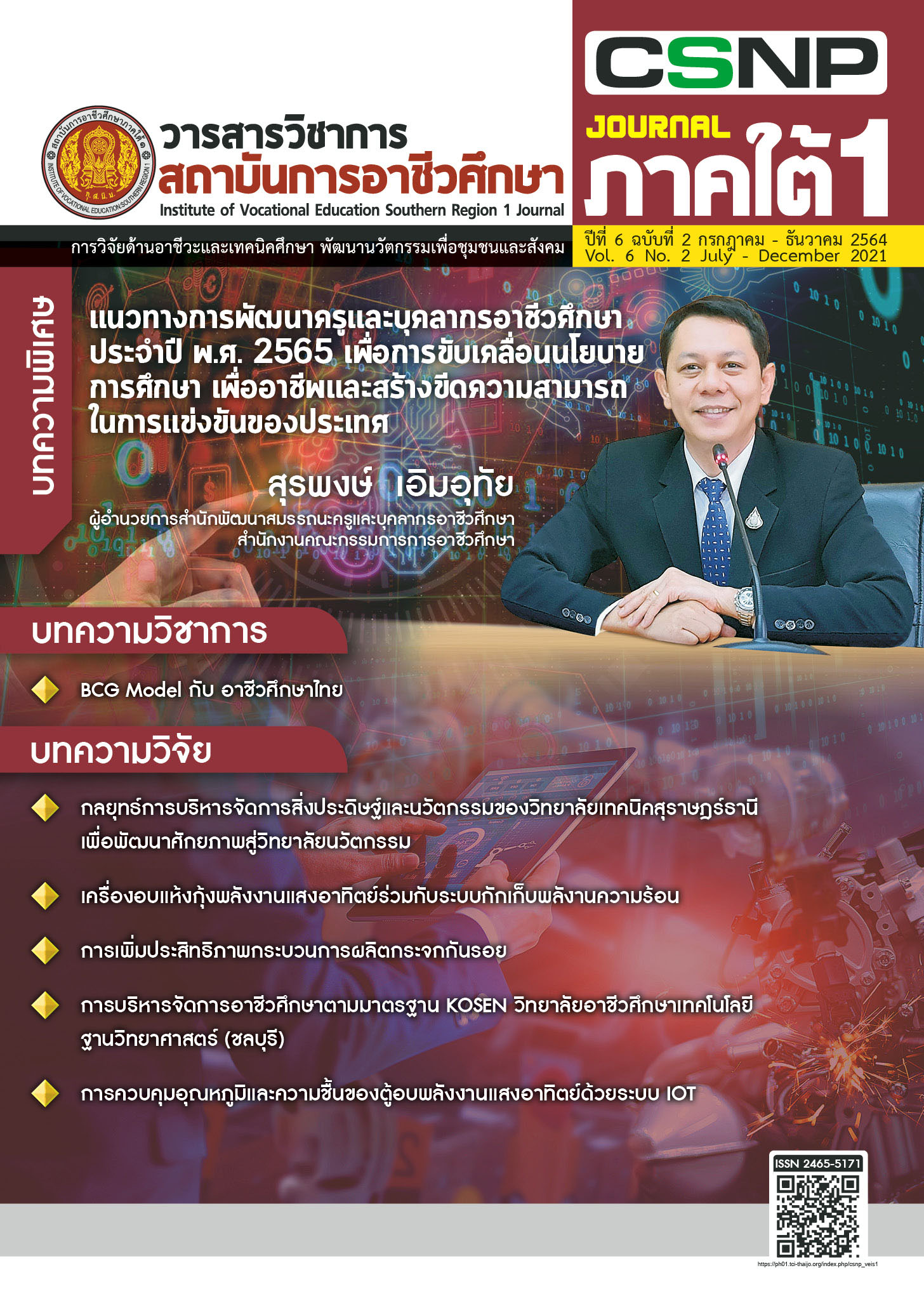การควบคุมอุณหภูมิและความชื้นของตู้อบพลังงานแสงอาทิตย์ด้วยระบบ IoT
คำสำคัญ:
ตู้อบพลังงานแสงอาทิตย์, การควบคุมอุณหภูมิและความชื้น, ระบบ IoTบทคัดย่อ
การวิจัยครั้งนี้มีวัตถุประสงค์เพื่อ 1) ออกแบบและสร้างตู้อบพลังงานแสงอาทิตย์แบบควบคุมอุณหภูมิและความชื้นด้วยระบบ IoT 2) ศึกษาสมรรถนะของตู้อบพลังงานแสงอาทิตย์ที่ควบคุมอุณหภูมิและความชื้นด้วยระบบ IoT และ 3) ประเมินความพึงพอใจของผู้ใช้ตู้อบพลังงานแสงอาทิตย์แบบควบคุมอุณหภูมิและความชื้นด้วยระบบ IoT กลุ่มตัวอย่าง ได้แก่ เกษตรกรผู้ประกอบอาชีพแปรรูปอาหารทะเล อำเภอกาญจนดิษฐ์ จังหวัดสุราษฎร์ธานี จำนวน 10 คน ได้มาโดยการคัดเลือกแบบเจาะจง เครื่องมือที่ใช้ในการวิจัยเป็นแบบบันทึกข้อมูลและแบบสอบถามความพึงพอใจ สถิติที่ใช้ในการวิจัย ได้แก่ ความถี่ ร้อยละ ค่าเฉลี่ย และส่วนเบี่ยงเบนมาตรฐาน
ผลการวิจัย พบว่า 1) ผลการออกแบบและสร้างตู้อบพลังงานแสงอาทิตย์แบบควบคุมอุณหภูมิและความชื้น ออกแบบตู้อบแบบ 3 ชั้น 6 ช่อง ใช้พลังงานไฟฟ้าในระบบจากแผงโซลาร์เซลล์ ตั้งค่าอุณหภูมิในตู้อบด้วยระบบ IoT ผ่านแอปพลิเคชันจากสมาร์ทโฟน อุณหภูมิในตู้อบตั้งไว้ที่ 50 ºC เมื่ออุณหภูมิต่ำจะสั่งการให้หลอดไฟทำงาน เมื่ออุณหภูมิสูงพัดลมจะระบายอากาศออกทำให้สามารถควบคุมอุณหภูมิในตู้อบให้อยู่ที่ 50 ºC ทุกช่วงเวลา 2) ผลการทดสอบสมรรถนะด้านความชื้นของวัตถุดิบ 3 ชนิด แต่ละชนิดในตู้อบพลังงานแสงอาทิตย์แบบควบคุมอุณหภูมิและความชื้นที่ตั้งไว้ 40% 25% และ 20% ตามลำดับ พบว่า เมื่อค่าความชื้นของวัตถุดิบ 3 ชนิด ลดเหลือตามค่าที่กำหนดตู้อบจะแสดงผลแจ้งเตือนมายังแอปพลิเคชันในสมาร์ทโฟนทุกครั้ง และวัตถุดิบที่ผ่านการอบมีสภาพสี สภาพผิว และความแห้ง จากการทดสอบโดยประสาทสัมผัสมีคุณภาพตามเกณฑ์ที่กำหนด และ 3) ผลการประเมินความพึงพอใจของผู้ใช้ พบว่า ในภาพรวมอยู่ในระดับมาก
เอกสารอ้างอิง
กระทรวงพลังงาน. (2562). [ออนไลน์]. โครงการสนับสนุนการลงทุนติดตั้งใช้งานระบบอบแห้งพลังงานแสงอาทิตย์ (พาราโบลาโดม) ประจำปี 2560. [สืบค้นเมื่อวันที่ 19 กรกฎาคม 2562]. จาก http://www.solardryerdede.com/?p=1823.
อนุสรณ์ ขาวเจริญ. (2556). การพัฒนาระบบควบคุมการทำงานของโรงเรือนอบแห้งพลังงานแสงอาทิตย์แบบเรือนกระจกหลังคารูปทรงพาราโบลา. วิทยานิพนธ์ปริญญามหาบัณฑิต สาขาวิชาฟิสิกส์ คณะวิทยาศาสตร์ มหาวิทยาลัยศิลปากร, นครปฐม.
กรมพัฒนาพลังงานทดแทนและอนุรักษ์พลังงาน. (2562). [ออนไลน์]. การผลิตความร้อนจากพลังงานแสงอาทิตย์. [สืบค้นเมื่อวันที่ 18 สิงหาคม 2562]. จาก https://www.dede.go.th/ewt_news.php?nid=539&filename=index.
แอลเอ บิสซิเนส อินเทลลิเจนซ์. (2562). [ออนไลน์]. ระบบแอปพลิเคชันและสมาร์ทโฟน eWelink. [สืบค้นเมื่อวันที่ 12 พฤศจิกายน 2562]. จาก https://www.labi.co.th/wp-content/uploads/2017/09/คู่มือการติดตั้งสมาร์ทสวิตช์-LAbi.pdf.
รัฐพงษ์ โป้เคน และวิศิษศักดิ์ เสงี่ยมศักดิ์. (2563). ตู้อบกล้วยพลังงานแสงอาทิตย์. วารสารวิชาการการประยุกต์ใช้เทคโนโลยีสารสนเทศ, ปีที่ 6 ฉบับที่ 1 มกราคม-มิถุนายน 2563, 48-57.
อนิรุทธิ์ ต่ายขาว และสมบัติ ทีฆทรัพย์. (2556). เครื่องอบแห้งพลังงานแสงอาทิตย์ชนิดพาความร้อนแบบธรรมชาติ และชนิดพาความร้อนแบบบังคับ. วารสารวิชาการมหาวิทยาลัยอีสเทิร์นเอเชีย, ปีที่ 7 ฉบับที่ 1 มกราคม-มิถุนายน 2556, 23-31.
ดาวน์โหลด
เผยแพร่แล้ว
ฉบับ
ประเภทบทความ
สัญญาอนุญาต
ลิขสิทธิ์ (c) 2021 วารสารวิชาการสถาบันการอาชีวศึกษาภาคใต้ 1

อนุญาตภายใต้เงื่อนไข Creative Commons Attribution-NonCommercial-NoDerivatives 4.0 International License.



